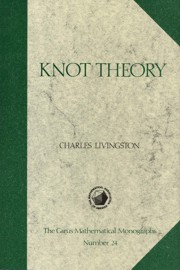Book contents
- Frontmatter
- ACKNOWLEDGEMENTS
- PREFACE
- Contents
- Chapter 1 A CENTURY OF KNOT THEORY
- Chapter 2 WHAT IS A KNOT?
- Chapter 3 COMBINATORIAL TECHNIQUES
- Chapter 4 GEOMETRIC TECHNIQUES
- Chapter 5 ALGEBRAIC TECHNIQUES
- Chapter 6 GEOMETRY, ALGEBRA, AND THE ALEXANDER POLYNOMIAL
- Chapter 7 NUMERICAL INVARIANTS
- Chapter 8 SYMMETRIES OF KNOTS
- Chapter 9 HIGH-DIMENSIONAL KNOT THEORY
- Chapter 10 NEW COMBINATORIAL TECHNIQUES
- Appendix 1 KNOT TABLE
- Appendix 2 ALEXANDER POLYNOMIALS
- REFERENCES
- INDEX
Chapter 1 - A CENTURY OF KNOT THEORY
- Frontmatter
- ACKNOWLEDGEMENTS
- PREFACE
- Contents
- Chapter 1 A CENTURY OF KNOT THEORY
- Chapter 2 WHAT IS A KNOT?
- Chapter 3 COMBINATORIAL TECHNIQUES
- Chapter 4 GEOMETRIC TECHNIQUES
- Chapter 5 ALGEBRAIC TECHNIQUES
- Chapter 6 GEOMETRY, ALGEBRA, AND THE ALEXANDER POLYNOMIAL
- Chapter 7 NUMERICAL INVARIANTS
- Chapter 8 SYMMETRIES OF KNOTS
- Chapter 9 HIGH-DIMENSIONAL KNOT THEORY
- Chapter 10 NEW COMBINATORIAL TECHNIQUES
- Appendix 1 KNOT TABLE
- Appendix 2 ALEXANDER POLYNOMIALS
- REFERENCES
- INDEX
Summary
In 1877 P. G. Tait published the first in a series of papers addressing the enumeration of knots. Lord Kelvin's theory of the atom stated that chemical properties of elements were related to knotting that occurs between atoms, implying that insights into chemistry would be gained with an understanding of knots. This motivated Tait to begin to assemble a list of all knots that could be drawn with a small number of crossings. Initially the project focused on knots of 5 or 6 crossings, but by 1900 his work, along with that of C. N. Little, had almost completed the enumeration of 10-crossing knots. The diagrams in Appendix 1 indicate the kind of enumeration he was seeking.
Tait viewed two knots as equivalent, or of the same type, if one could be deformed to appear as the other, and sought an enumeration that included each knot type only once. The difficulty of this task is illustrated by the four knots in Figure 1.1. For now a knot can be thought of simply as a loop of rope. With some effort it is possible to deform the second knot to appear untangled, like the first. On the other hand, no amount of effort seems sufficient to unknot the third or fourth. Is it possible that with some clever manipulation the third could be transformed to look like the fourth? If a list of knots is going to avoid knots of the same type appearing repeatedly, means of addressing such questions are needed.
- Type
- Chapter
- Information
- Knot Theory , pp. 1 - 10Publisher: Mathematical Association of AmericaPrint publication year: 1993



